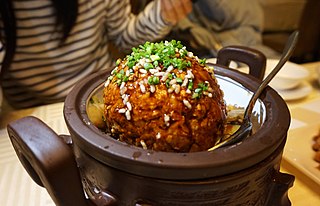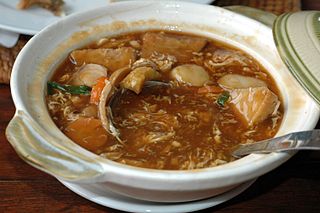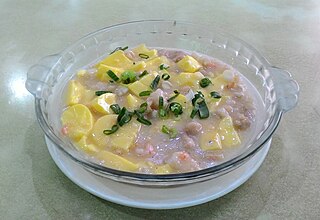
Teochew cuisine, also known as Chiuchow cuisine, Chaozhou cuisine or Teo-swa cuisine, originated from the Chaoshan region in the eastern part of China's Guangdong Province, which includes the cities of Chaozhou, Shantou and Jieyang. Teochew cuisine bears more similarities to that of Fujian cuisine, particularly Southern Min cuisine, due to the similarity of Teochew's and Fujian's culture, language, and their geographic proximity to each other. However, Teochew cuisine is also influenced by Cantonese cuisine in its style and technique.

Shanghai cuisine, also known as Hu cuisine, is a popular style of Chinese food. In a narrow sense, Shanghai cuisine refers only to what is traditionally called Benbang cuisine which originated in Shanghai. In a broader sense, it refers to complex styles of cooking developed under the influence of neighboring Jiangsu and Zhejiang provinces.

Lion's Head or stewed meatball is a dish from the Huaiyang cuisine of eastern China, consisting of large pork meatballs or beef meatballs stewed with vegetables. There are two varieties: white, and red. The plain variety is usually stewed or steamed with napa cabbage. The red variety can be stewed with cabbage or cooked with bamboo shoots and tofu derivatives. The minced meat rich in fat is more likely to bring better texture, addition of chopped water chestnut also works.

Ipoh has a significant food scene with many hawker centres and restaurants. It has dishes derived from Malay, Chinese and Indian cuisine. In recent years, Ipoh has seen an increase in international restaurants, bars and gastropubs which have become popular with locals and tourists.

Chinese Indonesian cuisine is characterized by the mixture of Chinese with local Indonesian style. Chinese Indonesians, mostly descendant of Han ethnic Hokkien and Hakka speakers, brought their legacy of Chinese cuisine, and modified some of the dishes with the addition of Indonesian ingredients, such as kecap manis, palm sugar, peanut sauce, chili, santan and local spices to form a hybrid Chinese-Indonesian cuisine. Some of the dishes and cakes share the same style as in Malaysia and Singapore, known as Nyonya cuisine by the Peranakan.

Huaiyang or Jianghuai cuisine is one of the Four Great Traditions in Chinese cuisine. It is derived from the native cooking styles of the region surrounding the lower reaches of the Huai and Yangtze rivers and centered on the cities of Huai'an, Yangzhou and Zhenjiang in Jiangsu Province. Although it is one of several sub-regional styles within Jiangsu cuisine, Huaiyang cuisine is widely seen in Chinese culinary circles as the most popular and prestigious style of Jiangsu cuisine, to a point where it is considered to be one of the Four Great Traditions that dominate the culinary heritage of China, along with Cantonese cuisine, Shandong cuisine, and Sichuan cuisine.

Chinese imperial cuisine is derived from a variety of cooking styles of the regions in China, mainly from the cuisines of Shandong and Jiangsu provinces. The style originated from various Emperors' Kitchen and the Empress Dowagers' Kitchen, and it is similar to Beijing cuisine which it heavily influenced.

Chinese aristocrat cuisine traces its origin to the Ming and Qing dynasties when imperial officials stationed in Beijing brought their private chefs and such different varieties of culinary styles mixed and developed over time to form a unique breed of its own, and thus the Chinese aristocrat cuisine is often called private cuisine. The current Chinese aristocrat cuisine is a mixture of Shandong cuisine, Huaiyang cuisine and Cantonese cuisine. As Beijing was the capital of the last three Chinese dynasties, most of the Chinese aristocrat cuisine originated in Beijing. Currently, there are a total of nine varieties of Chinese aristocrat cuisine.

Tofu skin roll or Tofu roll is a dim sum dish. It can be found in Hong Kong and among overseas Chinese restaurants. It is usually served in a small plate in twos or threes. In all cases, the outer layer is made of tofu skin.

Tofu is a food prepared by coagulating soy milk and then pressing the resulting curds into solid white blocks of varying softness: silken, soft, firm, extra firm. Tofu is also known as bean curd in English. It is a traditional component of East Asian and Southeast Asian cuisines that has also been consumed in China for over 2,000 years. In modern Western cooking, it is sometimes used as a meat substitute.
Wenlou Tang bao is a large tangbao served in Wenlou, Huai'an, Jiangsu, China. The local residents also call it crab roe tangbao. It is a dish in Huaiyang cuisine.

Chinese regional cuisines are amongst the many different cuisines found in different provinces and prefectures of China as well as from larger overseas Chinese communities.

Buddha's delight, often transliterated as Luóhàn zhāi, lo han jai, or lo hon jai, is a vegetarian dish well known in Chinese and Buddhist cuisine. It is sometimes also called Luóhàn cài.

Kung Pao chicken, also transcribed Gong Bao or Kung Po, is a spicy, stir-fried Chinese dish made with cubes of chicken, peanuts, vegetables and chili peppers and Sichuan peppercorns. From its origins in Sichuan cuisine, the dish's popularity has spread throughout China, spawning a number of regional variations some of which are less spicy than the classic version.

Almond tofu is a soft, jellied dessert made of apricot kernel milk, agar, and sugar popular throughout East Asia.

Dazhu gansi is a specialty dish of Huaiyang cuisine. Dried tofu is sliced into matchsticks and served in chicken stock. Many other ingredients can be added to the tofu. As tofu does not have much flavor, the chef is challenged to produce knifework of great precision and a broth of the highest quality. It is said to have been created in Yangzhou for the Qianlong emperor.

Patriotic soup is a vegetable soup originated by Teochew people. It was developed during the final year of China's Song dynasty as an improvisational dish.

Sapo tahu is a Chinese Indonesian tofu dish traditionally cooked and served in claypot. Sapo tahu may be served as a vegetarian dish, or with chicken, seafood, minced beef or pork. It is a popular tofu dish in Indonesia, with several Chinese restaurants competing to serve the best-tasting sapo tahu in Jakarta.

Mun tahu is Chinese Indonesian dish of soft tofu braised in savoury thick white sauce, mixed with minced chicken and shrimp.












